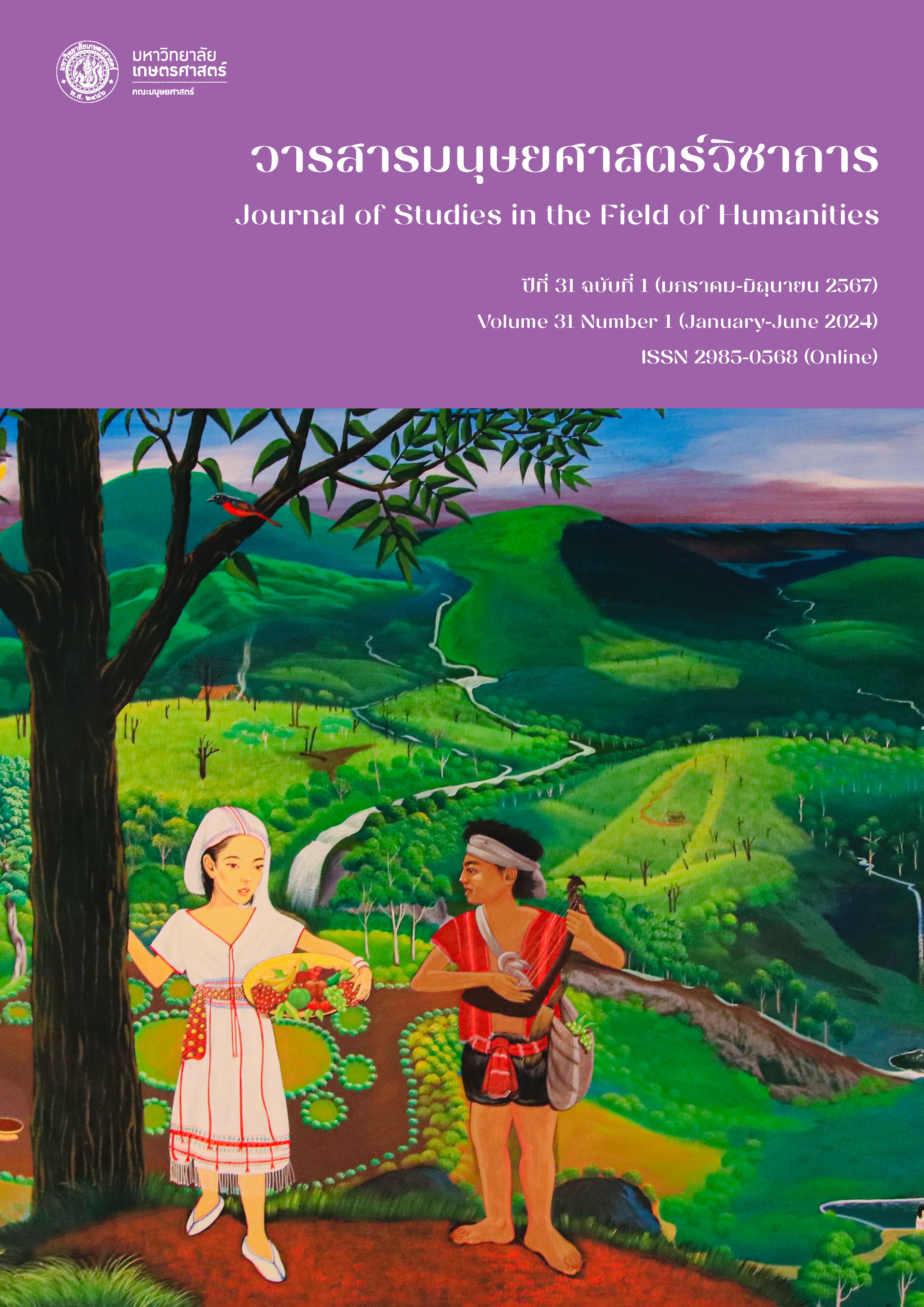Grammaticalization of the Word /mák/
Main Article Content
Abstract
This research aims to study the linguistic change of the word /mák/ in terms of grammaticalization in the old Thai corpus, spanning from 1339 AD (the Sukhothai era) to 1907 AD (1882-2450 BE). The results indicate that /mák/ grammaticalized from a verb 'like' to an adverb-auxiliary 'frequentative.' The grammaticalization of /mák/ began when /mák/ occurs as the first verb in a serial verb construction, leading to structural and pragmatic ambiguities. These ambiguities in the usage of /mák/ permit a reanalysis of its grammatical functions, shifting from the main verb to the adverb-auxiliary. Moreover, the ambiguities also facilitate inference through a metonymic process in the case that someone who likes to do something tends to do that thing frequently. The adverb-auxiliary /mák/ 'frequentative' which initially emerged in
a certain context further underwent analogy and metaphorical processes and extended its use, as evidenced by three instances. First, it expanded its co-occurrence from animate subjects to inanimate subjects. Second, it broadened its co-occurrence from action verbs to experience and stative verbs. Third, its syntactic structure came to resemble that of
an aspectual marker.
Article Details

This work is licensed under a Creative Commons Attribution-NonCommercial-NoDerivatives 4.0 International License.
References
กรมตำรา. (2470). ปทานุกรม. พระนคร: โรงพิมพ์กรมตำรา กระทรวงธรรมการ.
กรมศิลปากร. (2545). ปูมราชธรรม เอกสารสมัยอยุธยาจากหอสมุดแห่งชาติกรุงปารีส. กรุงเทพฯ: กรมศิลปากร.
กรมศิลปากร. (2554). ไตรภูมิ เอกสารจากหอสมุดแห่งชาติกรุงปารีส. กรุงเทพฯ: กรมศิลปากร.
กิ่งกาญจน์ เทพกาญจนา. (2559). กระบวนการกลายเป็นรูปไวยากรณ์. กรุงเทพฯ: อมรินทร์พริ้นติ้งแอนด์พับลิชชิ่ง จำกัด (มหาชน).
นววรรณ พันธุเมธา. (2558). ไวยากรณ์ไทย (พิมพ์ครั้งที่ 7). กรุงเทพฯ: โครงการเผยแพร่ผลงานวิชาการคณะอักษรศาสตร์ จุฬาลงกรณ์มหาวิทยาลัย.
ภาควิชาภาษาศาสตร์ คณะอักษรศาสตร์ จุฬาลงกรณ์มหาวิทยาลัย. (2551). TNC: Thai National Corpus (3rd ed.). สืบค้นจาก https://www.arts.chula.ac.th/ling/tnc3/.
ราชบัณฑิตยสถาน. (2556). พจนานุกรมฉบับราชบัณฑิตยสถาน พ.ศ. 2554. กรุงเทพฯ: นานมีบุ๊คส์.
สัณห์ธวัช ธัญวงษ์. (2566). คำ “ภาย”: การศึกษาตามแนวคิดเรื่องกระบวนการเกิดคำใหม่และการกลายเป็นรูปไวยากรณ์. ภาษาและภาษาศาสตร์, 41(2), 1-30.
สุรีเนตร จรัสจรุงเกียรติ. (2551). ยัง: การศึกษาเชิงประวัติ (วิทยานิพนธ์มหาบัณฑิต). จุฬาลงกรณ์มหาวิทยาลัย, กรุงเทพฯ.
อภิญญา สร้อยธุหร่ำ. (2553). พหุหน้าที่ของคำว่า “จะ” ในภาษาไทย (วิทยานิพนธ์ดุษฎีบัณฑิต). จุฬาลงกรณ์มหาวิทยาลัย, กรุงเทพฯ.
Anthony, L. (2023). AntConc (version 4.2.4) (computer software). Retrieved from https://www.laurenceanthony.net/software.
Bradley, D. B. (1873). Dictionary of the Siamese language. Bangkok: D.B. Bradley.
Brezina, V. (2018). Statistics in corpus linguistics: A practical guide. Cambridge: Cambridge University Press.
Caswell, J. (1846). A Dictionary of the Siamese language (Copied and enlarged by J.H. Chandler). Bangkok: Chulalongkorn University Press.
Chormai, P., Prasertsom, P., & Rutherford, A. (2019). Attacut: A fast and accurate neural Thai word segmenter. Retrieved from https://arxiv.org/abs/1911.07056.
Diller, A. (2001). Grammaticalization and Tai syntactic change. In K. M. R. Tingsabadh, & A. S. Abramson, (Ed.), Essays in Tai linguistics (pp. 139-176). Bangkok: Chulalongkorn University Press.
Enfield, N. (2007). A Grammar of Lao. Berlin: De Gruyter Mouton.
Haas, M. R. (1964). Thai-English student’s dictionary. Stanford, CA: Stanford University Press.
Hopper, E. C., & Traugott, E. C. (2003). Grammaticalization (2nd ed.). Cambridge: Cambridge University Press.
Hudak, T. J. (2007). William J. Gedney’s comparative Tai source book. Honolulu: University of Hawaii Press.
Jones, E. G. (1833). Thai-English Dictionary. Retrieved from http://sealang.net/dictionary/jones/.
Kuteva, T., Heine, B., Hong, B., Long, H., Narrog, H., & Rhee, S. (2019). World lexicon of grammaticalization. Cambridge: Cambridge University Press.
Lakoff G., & Johnson, M. (2003). Metaphors we live by. Chicago: The University of Chicago Press.
Langacker, R. (1977). 2. Syntactic Reanalysis. In C. Li (Ed.), Mechanisms of syntactic change (pp. 57-140). New York: University of Texas Press.
Noss, R. B. (1964). Thai reference grammar. Foreign Service Institute, Washington, DC: Department of State.
Pallegoix, J. B. (1854). Dictionarium linguae Thaĭ. Parisiis: Jussu Imperatoris Impressum.
Pothipath, V. (2023). Comitatives and instrumentals in Thai: A diachronic typological perspective. Manusya: Journal of Humanities, 26(1), 1-20.
Tansiri, K., & Thepkanjana, K. (2015). Functional extension of the verb for ‘to like’ in Thai to the frequentative aspectual marker. Paper presented at the 32nd Annual Meeting of the Southeast Asian Linguistics Society (SEALS 2015), Chiang Mai, Thailand.
Tansiri, K., Thepkanjana, K., & Kaenmuang, J. (2023). Functional extension of the verb for ‘to like’ in Thai to the frequentative aspectual marker. Unpublished manuscript.
Trask, R. L. (1993). A dictionary of grammatical terms in linguistics. London and New York: Routledge.
Vickery, M. (1974). A note on the date of the Traibhumikatha. Journal of the Siam Society, 62(2), 275-284.
Vickery, M. (1991). On Traibhumikatha. Journal of the Siam Society, 79(2), 24-36.


